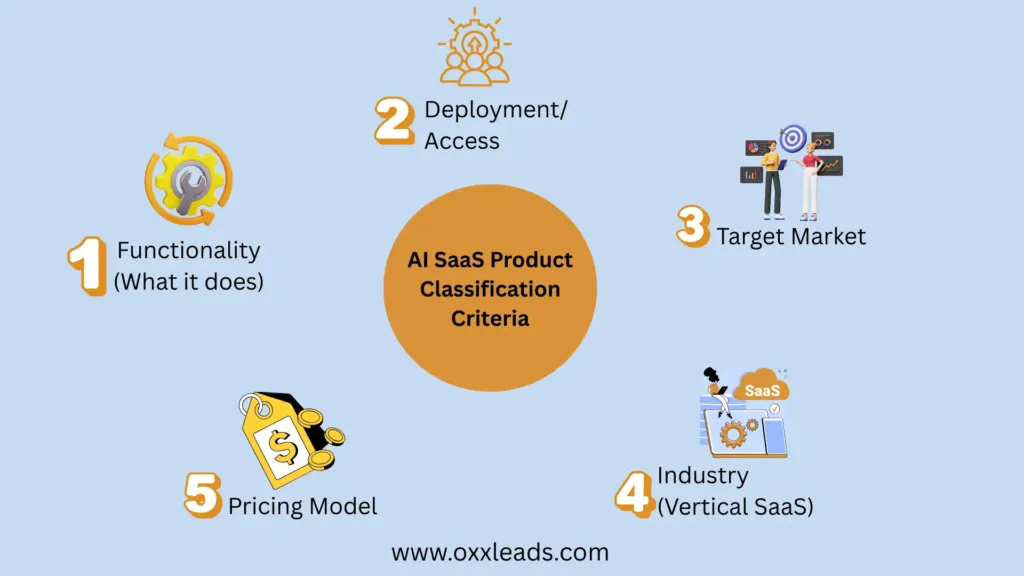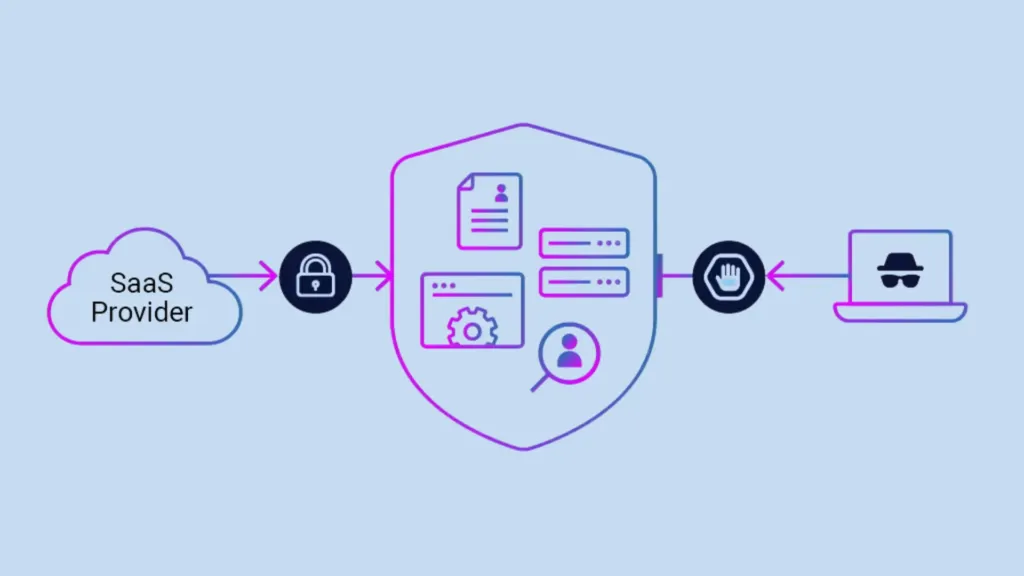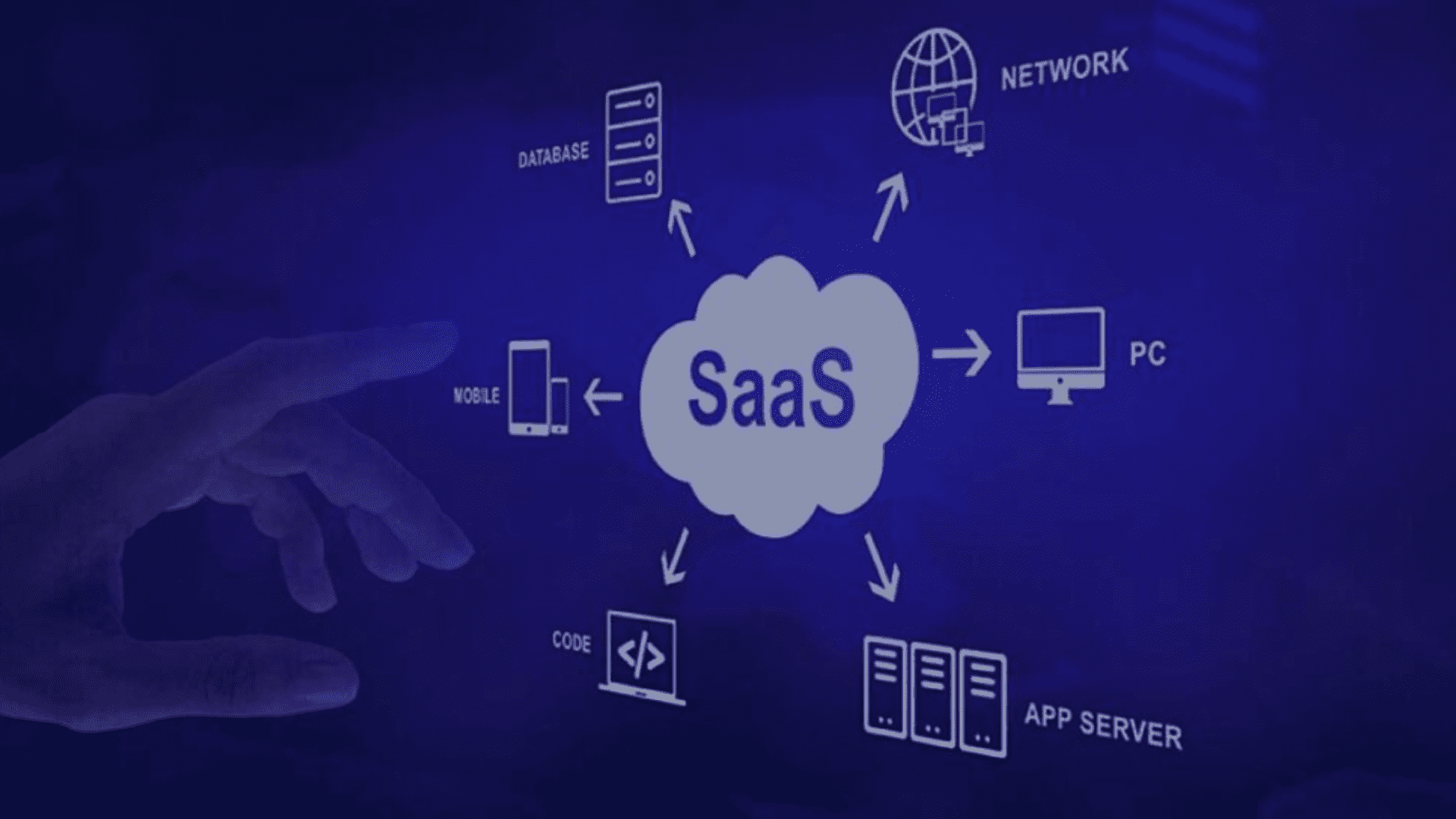Artificial Intelligence has become the backbone of modern SaaS (Software-as-a-Service) products. AI-powered SaaS solutions are rapidly changing businesses through the automation of HR procedures, the facilitation of predictive analytics, and the provision of highly customised consumer experiences. Product classification is, nevertheless, one of the most neglected aspects of SaaS success.
Correctly classifying an AI SaaS product is more than just labelling; it determines how investors, consumers, and even search engines like Google perceive your offering. When done properly, classification speeds up acceptance, creates clarity, and positions your brand for expansion.
In this guide, we’ll explore the AI SaaS product classification criteria, why it matters, and how you can use it to strengthen your go-to-market strategy, investor narrative, and SEO performance.
Why Do You Need to Classify Your SaaS Product?
Consider releasing a powerful AI SaaS solution that addresses an actual business problem. Customers are still unable to distinguish between a CRM, an HR automation tool, and a predictive analytics platform. This confusion alone has the potential to discourage investors, impede adoption, and damage your brand’s positioning.
Proper classification ensures that the right audience easily understands your SaaS solution. It clears up any confusion for clients and explains how your solution works with their workflows. It lets investors know that you’re in a well-known and comparable industry. It provides your marketing team with a starting point for targeted messaging and SEO tactics.
To put it briefly, accurate classification matches how you define your product to how the market views and looks for it.
How Do You Identify the Right Use Case for Your SaaS Product?
The cornerstone of classification is the use case your product addresses. A clear use case ties your solution to a specific problem and audience, making it easier to communicate value.
The process begins with understanding the core problem your product is designed to solve.
Steps to identify the right use case:
- Start with the pain point – What real-world challenge does your AI SaaS product address?
- Map functionality to workflows – Is it a fit within sales, marketing, HR, finance, or industry-specific workflows?
- Assess user intent – Are users looking for “AI CRM,” “AI HR software,” or “AI data analytics tool”?
- Check market demand – Utilise Google Trends, keyword tools, and competitor analysis.
- Validate with early adopters – Beta test to ensure usability and adoption.
Example Use Cases and Classification
| Use Case | AI SaaS Classification | Example |
| Automating HR screening | AI-powered HR SaaS (Vertical SaaS) | HireVue, Pymetrics |
| Predicting customer churn | AI CRM SaaS (Horizontal SaaS) | Salesforce Einstein |
| Fraud detection | AI Fintech SaaS (Vertical SaaS) | Feedzai |
| Personalized shopping | AI E-commerce SaaS (Horizontal SaaS) | Dynamic Yield |
The Role of Buyer Personas in Product Classification
Buyer personas aren’t only for marketing campaigns; they have a direct impact on how your SaaS should be categorised. One built for a CFO at a mid-sized financial company is much different from one built for a startup marketing manager.
Buyer persona considerations:
- Job function (CFO, CMO, HR Director, IT Manager)
- Industry (Finance, Healthcare, E-commerce, SaaS)
- Company size (SMB vs Enterprise)
- Pain points (Efficiency, cost savings, compliance)
The more detailed your persona, the more precise your classification.
How Pricing Models Influence SaaS Classification
Pricing models are frequently a neglected but potent indicator of classification.
- A freemium or low-fee model commonly indicates a horizontal SaaS tool for startups or SMBs.
- Enterprise agreements are more prevalent in vertical, industry-vertical solutions.
- Usage-based pricing, conversely, is most frequently linked to infrastructure-level SaaS such as APIs or AI model hosting platforms.
Pricing Model vs Product Category
| Pricing Model | Likely Product Category | Example |
| Freemium + upgrade tiers | Horizontal, SMB SaaS | Slack, Notion |
| Enterprise contracts | Vertical SaaS, AI enterprise apps | Workday |
| Usage-based pricing | API-first SaaS, infrastructure | OpenAI API |
By tying pricing to classification, you establish consistency within your business model and in how the market perceives you.

Technology Stack as a Classification Signal
The actual tech stack itself speaks to the categorisation of a SaaS product
- NLP & LLM-based SaaS: An NLP and large language model-powered solution tends to suggest AI chatbots, content creation, or voice assistants.
- Predictive analytics engines: Suggest SaaS products that fit into forecasting and data intelligence.
- Computer vision capabilities fit naturally into healthcare imaging or security SaaS.
- RPA + AI: Robotic Process Automation (RPA) combined with AI falls under HR, finance, or IT automation.
Your tech stack should thus not only be functional but also convey your category. It’s part of the story that tells investors, customers, and search engines what your SaaS actually stands for.
Handling SaaS Products That Span Multiple Categories
It’s not unusual for AI SaaS products to have crossover categories. For example, a product centred on HR might also include workforce analytics that border on business intelligence. When this is the case, it’s best to select one primary classification to base your messaging and SEO approach on. Secondary categories can be referenced in ancillary content or segmented landing pages, but without the anchor of a main one, your product can seem loose and unfocused.
Why Classification Matters for Investors and Go-To-Market Strategies
Investors analyse SaaS companies partly on how well-defined or new they are to established or evolving categories. If they’re unable to pin your product onto a known market space, it’s more difficult to gauge market size, competitive dynamics, and potential for growth. Clean categorisation not only engenders investor trust but also helps shape your go-to-market plan, including:
- Pricing strategy
- Sales enablement
- Customer acquisition channels
Vertical vs Horizontal SaaS: A Key Classification Factor
Yet another key difference is whether your SaaS is vertical or horizontal.
- Vertical SaaS products are industry-specific. They typically provide deep features, compliance alignment, and integrations that are highly valuable within that niche.
- Horizontal SaaS products, in contrast, target multiple industries with less-specific solutions.
Vertical vs Horizontal SaaS Traits
| Type | Traits | Example |
| Vertical SaaS | Niche focus, deep integrations, compliance-driven | Veeva (pharma SaaS) |
| Horizontal SaaS | Broad market, general integrations, scalable | HubSpot |
Labelling your SaaS product correctly within this framework affects everything from SEO keywords to investor positioning.
How Google Understands SaaS Classification

Google draws upon a set of signals to determine what your SaaS product is. Titles, headings, and on-page copy offer textual hints. Schema markup like SoftwareApplication assists Google with more accurate categorisation of your product. Following this, backlinks from industry sites within a specific category verify your connection with that category. To achieve SEO visibility, having your classification match the way Google is reading your content is crucial.
Evolving Products and Changing Classifications
Most SaaS products mature, gaining new features or changing direction. If your product is about to mature, start with a coarse initial classification that states the underlying problem you solve. Later on, as the product matures, you can change classification, but do it consistently. Communicate changes clearly through your website, content strategy, and investor decks so that you do not confuse people.
How Classification Impacts SEO and Content Strategy
Classification determines your entire SEO strategy. A well-defined category enables you to create content clusters based on relevant keywords, post industry-specific case studies, and optimise product pages for intent-based searches. For instance, an AI SaaS categorised as “AI HR software” should create SEO assets around hiring automation, workforce analytics, and compliance in HR.
Content categorisation also makes sure that internal linking is useful and assists search engines in comprehending relationships among various pages on your site.
Repositioning Your SaaS Product Without Confusing Users
Occasionally, SaaS companies must reposition their offerings, either because markets shift or features change. Careful communication is needed to reposition successfully. Existing customers have to know why the change is taking place, and SEO content has to reflect it. Any old URLs must be able to redirect to new ones, but tutorial items like webinars and blog posts can ease the transition for current users.
Classification as a Guide for Feature Development
Your classification must guide your product roadmap. A SaaS product classified as HR automation must focus on features like AI-based candidate filtering, payroll processing, and compliance tracking, not create non-connected features to dilute the fundamental classification.
Classification in this way keeps product development aligned with strategy.
Benchmark Your SaaS Product Against Competitors
Classification also helps with competitive benchmarking. By comparing your product to others in the same category, you can evaluate strengths and weaknesses across pricing, features, integrations, and adoption.
Competitive Benchmarking Framework
| Criteria | Your Product | Competitor A | Competitor B |
| Pricing | $X / month | $Y / month | $Z / month |
| Core features | X, Y, Z | X, Y | X, Y, Z + A |
| User base size | 10,000 | 50,000 | 30,000 |
| Integrations | 10 | 30 | 20 |
This analysis puts you in a position where you can win.
How AI SaaS Product Classification Affects Product-Led Growth (PLG)
Product-led growth depends on customers quickly comprehending and embracing your SaaS. Simple categorisation speeds up onboarding by establishing correct expectations. If users immediately “get” what your product is about, they are likely to self-serve, discover features, and ultimately upgrade. OpenView Partners states that PLG not only reduces acquisition costs but also accelerates global adoption of SaaS products.
Can AI Help Refine Product Classification?
AI tools can refine classification by examining user behaviour, keyword data, and competitor positioning. Tools such as:
- SurferSEO, MarketMuse can determine how your content matches industry categories
- AI assistants such as ChatGPT can assist with creating messaging frameworks.
These clues avert misclassification and make sure your SaaS communicates effectively.
Team Alignment in the Classification Process
Classification must not be a top-down choice. Engaging your team via a brief alignment workshop can uncover great insights. By jointly determining the main use case, buyer personas mapping, and main vs secondary categories agreement, you ensure classification is adopted throughout sales, marketing, and product development.
Classification, Valuation, and Investor Narratives
Investors are keen to see classification when they evaluate SaaS businesses. A product that belongs in a high-growth vertical with evident benchmarks tends to carry higher valuations.
Clear presentation of your classification through market research, competitive analysis, and adoption is more persuasive and indicates market fit.
Using Classification to Attract Early Adopters
Early adopters are generally busiest in niche forums, communities, and professional networks such as LinkedIn groups, Reddit forums. By mapping your SaaS category to their interests, you can make targeted campaigns and landing pages that speak to them in a very intimate way. This kind of precision makes beta testing and early adoption easier, with the result that you’re gaining momentum in the market.
What Role Does Classification Play in Building a Winning SaaS Brand?
Powerful SaaS brands typically dominate their categories. Salesforce is the default for CRM SaaS, and Zoom is the default for video conferencing. Clear categorisation enables you to claim your space, establish authority, and achieve enduring brand recognition. Without it, your brand will be diluted and easily forgettable.
Sales and Marketing Alignment
Lastly, classification unites sales and marketing teams. With one understanding of your product category, sales can leverage custom battle cards, and marketing can create content clusters. This process ensures uniform messaging across customer touchpoints, leading to trust and faster conversions.
FAQs About AI SaaS Product Classification Criteria
1. How do investors perceive SaaS product classification?
Investors tend to analyse SaaS startups on a category basis. Proper classification makes it easier for investors to compare you to benchmarks (such as churn rate, ARPU, and LTV) for that category. Without proper classification, it is more difficult to demonstrate market fit and growth prospects.
2. Does product classification affect SaaS pricing models?
Yes. SaaS categories tend to have “normal” pricing assumptions. For instance, project management SaaS tends to be seat-based, whereas analytics SaaS might be priced per data usage. Having an understanding of your category allows you to fit into pricing models your audience already understands.
3. How does SaaS classification affect customer trust?
When customers immediately identify your category, they can immediately compare you to familiar tools. This reduces friction and increases trust. If you have an ambiguous classification, customers will be unsure if your solution is right for them.
4. What errors should SaaS startup founders make when product classifying?
Some common errors are:
- Selecting too general a classification (e.g., simply “productivity tool”)
- Classification changes too often
- Establishing a “new” category without teaching the market
- Mimicking rival classification without adapting to your capabilities
5. Does SaaS classification assist with product-led growth (PLG)?
Yes. Clear classification makes it immediately clear to potential users the value of your product. For PLG, where the product sells itself, having clarity in classification minimizes onboarding friction and maximizes adoption.
6. How does SaaS classification impact international expansion?
Various regions might define categories differently. For instance, “CRM” could be the prevailing categorisation in the US, whereas “customer engagement platform” would be more popular within Europe. Changing classification for regional markets can enhance adoption.
7. Can AI tools assist in defining SaaS classification?
Platforms such as G2 and CB Insights apply AI-based market mapping to propose the optimal match for SaaS products. Entrepreneurs are able to examine competitor positioning, keyword grouping, and user intent data to make refinements in classification.
Let Your Classification Do the Heavy Lifting
AI SaaS product categorisation is not a technical nuance—it’s a strategic choice that influences branding, investor relations, product development, SEO, and growth. By thoughtfully determining your use case, buyer persona, pricing model, and technology stack, you can set your product up for long-term success.
At OxxLeads, we assist SaaS founders not only in optimising classification but also in scaling visibility by using SEO, content strategy, and growth marketing.

